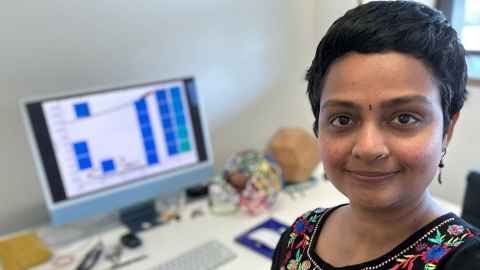Take 10 with... Priya Subramanian
Dr Priya Subramanian from the Department of Mathematics gives us 10 minutes of her time to discuss her work examining self-assembled patterns.

1. Describe your research topic to us in 10 words or less.
Understanding self-assembled patterns that arise when soft matter crystallises.
2. Now describe it in everyday terms!
Freezing of materials like polymers/gels can create complex patterns with widely different material properties. As an applied mathematician I use the simplest models that can stabilize such complex patterns, so that I can identify minimal mechanisms that can create them.
3. What are some of the day-to-day research activities you carry out?
No one day is like another and my research activities vary widely depending on which stage of a project I am in! Beginnings of a project mostly see me reading different papers detective-style, by trying to summarise them for the questions that I have in mind. Towards the end of a project, I am usually talking to my collaborators, writing and making pretty pictures/videos of our results.
4. What do you enjoy most about your research?
The moment when you have a brand new result and you understand why that happens. This is when I feel like I am the only one in the world who knows this tiny new result! Equally beautiful is the moment when I explain an idea or result and see the ‘aha’ moment happen to someone in the audience/student/collaborator.
Being able to do research lets me decide what is worth pursuing and forces me to convince others to fund it. Both of these are not fun when I do it, but they are interesting parts of the process once I get through them and see them in hindsight.
5. Tell us something that has surprised or amused you in the course of your research.
When I show pictures of quasicrystals or of related aperiodic tilings and talk to students, artists or the public, I am always amazed at how quickly and accurately they arrive at asking the most difficult and open questions that researchers are also seeking answers for! Only the words they use are different. When there is an answer for one such open question, like the recent result of a single tile that can create an aperiodic tiling, it is amazing and is of interest to everyone. However the answer of how the solution works is rarely as the accessible as the question. Instances where the questions are easy and the answers are complicated are probably the most celebrated results that non-researchers know.
It is amusing to think that most often in regular science, it is the opposite that occurs: i.e., that forming the correct question takes the bulk of our time: about what is not yet done but doable, still interesting and relevant; with their answers becoming much easier to obtain once the correct questions are identified. I suppose this approach is harder to write into a book or a screenplay!
6. How have you approached any challenges you’ve faced in your research?
I have always found it easy to start projects and challenging to finish projects. The most important lesson from my extra-long PhD was how to be stubborn enough (even with myself) to finish projects. My approach to handle this challenge in my post-doctoral life has been to create external deadlines (like saying yes to a conference or regular chats with collaborators/mentors), that motivate or rather force me to identify bite-size doable next things, do them and thus have some progress to share.
7. What questions have emerged as a result?
One of my early results in the area of soft matter crystallisation have shown that the same mechanisms that create quasicrystals on a surface (2D) are sufficient to create quasicrystals in bulk (3D). The question that has emerged as a result is why then we have yet to observe 3D quasicrystals in experimental soft matter systems. I am still working towards understanding/explaining this.
8. What kind of impact do you hope your research will have?
Soft matter surround us from food to LEDs and plastics, while quasicrystals are arrangements that have interesting physical properties (e.g., metallic quasicrystals have extremely low friction which makes them ideal for coatings where we want to minimise friction). I hope that being able to understand and direct the formation of soft matter quasicrystals will allow us to control many of the physical properties of the resulting soft matter.
9. If you collaborate across the faculty or University, or even outside the University, who do you work with and how does it benefit your research?
I do collaborate widely and work with colleagues in UK, USA and Australia. Previously I have also worked additionally with collaborators in India and Germany.
I am currently establishing new contacts with colleagues in other departments and am looking to form new collaborations!
10. What one piece of advice would you give your younger, less experienced research self?
Research is largely focused on extremely long-term goals/questions with unclear immediate strategies to approach them and even less clear ways to measure meaningful progress towards them. So irrespective of the stage of your career, one thing that is always present is the feeling that even though you have made what feels like progress in one of your projects, on any given day there are at least 3 or 4 other projects where you are trailing behind.
I would tell my younger self (and even my older future-selves) that survival in academia hinges on how kindly we treat ourselves in the no-man’s land between what we can do and all that we should be doing!